United States commemorative coin

The United States has minted numerous commemorative coins in remembrance of particular persons, places, events, and institutions. These coins are legal tender but are not intended for general circulation.[1]
History
Many consider the 1848 2½ dollar gold piece counter stamped "CAL" to be the first U.S. commemorative coin, as it commemorated the finding of gold in California.[2]
Most standard lists begin with the 1892 half dollar commemorating the 400th anniversary of Columbus' voyage to America. The following year, the Columbian Exposition quarter dollar featuring Queen Isabella of Spain was issued.[3]
Most students of U.S. commemorative coinage acknowledge the gap between 1954 and 1982 by classifying those minted from 1892 to 1954 as Early Commemoratives,[4] and those minted since 1982 as Modern Commemoratives.[5]
The 1926 Sesquicentennial half dollar has the bust of George Washington (who actually was not President in 1776) and Calvin Coolidge (though U.S. forbids images of living persons on currency or coins and he is the only President placed on U.S. currency or coin in his lifetime). The reverse side depicts the Liberty Bell. The 1926 Sesquicentennial quarter has Lady Liberty on the obverse side. The reverse side depicts Independence Hall.
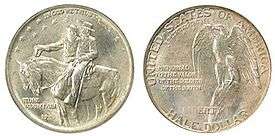
In 1925, a commemorative 50-cent coin was released that showed Robert E. Lee and Stonewall Jackson. Money raised from the sale of the coins was combined with money raised by the United Daughters of the Confederacy and the Stone Mountain Confederate Memorial Association in order to fund the carving of a Confederate monument at Stone Mountain.[6]
The U.S. Mint was criticized for commemorative issues of dubious recognition and seemingly endless mint runs. As an example of the latter, the Oregon Trail Memorial 50-cent piece was minted 8 years during a 14-year span. Multiple unrelated commemoratives also were minted in many years, diminishing the significance of commemorative issues. In 1936 alone the following 19 commemorative half dollars were minted: Oregon Trail Memorial, Texas Centennial half dollar, Daniel Boone Bicentennial half dollar, Arkansas Centennial half dollar, California Pacific International Exposition half dollar, Rhode Island Tercentenary half dollar, Cleveland Centennial half dollar, Wisconsin Territorial Centennial half dollar, Cincinnati Music Center half dollar, Long Island Tercentenary half dollar, Bridgeport, Connecticut Centennial half dollar, Lynchburg, Virginia Sesquicentennial half dollar, Elgin, Illinois, Centennial half dollar, Albany Charter half dollar, San Francisco-Oakland Bay Bridge half dollar, Columbia, South Carolina Sesquicentennial half dollar, Delaware Tercentenary half dollar, Battle of Gettysburg half dollar, and Norfolk, Virginia, Bicentennial half dollar. A half-dollar commemorative coin of the sesquicentennial anniversary of the Louisiana Purchase was proposed in 1952, but ultimately failed to go into mint and the period of Early Commemoratives soon after ended with the 1954 issues of the Washington–Carver 50-cent piece.[3][7]
Circulating commemorative coins
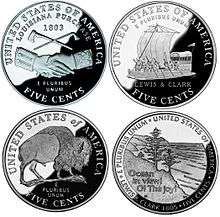
Circulating commemorative coins have been somewhat more unusual in the United States. These are coins that are minted to commemorate a particular person, place, event, or institution, but are intended to enter general circulation.
In 1932, the 200th anniversary of the birth of George Washington, the mint produced a circulating commemorative, the Washington Quarter. In 1934 (with no quarters produced in 1933), it became the regular issue coinage design.
In 1975 and 1976, the Washington quarter was also used to commemorate the United States Bicentennial with a circulating commemorative. The Kennedy half-dollar and Eisenhower dollar also featured commemorative designs for circulation during these two years. (All U.S. Bicentennial commemoratives were dated 1776–1976, despite being produced throughout 1975-76.)
More recently, the State Quarters program began in 1999 circulating five different commemoratives each year with reverses for each of the 50 States in the order of their admission to the Union. In 2007, six quarters commemorating the District of Columbia, two commonwealths, and three territories were added to the program for issue in 2009.[8][9]
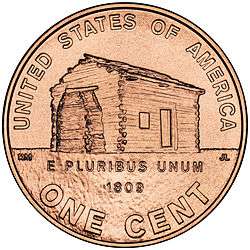
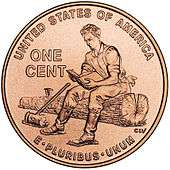
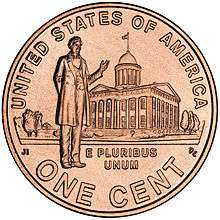
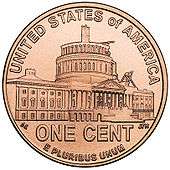
In 2004–2005 the mint issued four commemorative nickel five cent pieces in the Westward Journey Nickel Series, celebrating the 200th anniversaries of the Louisiana Purchase and the Corps of Discovery.
In 2009, four commemorative one cent pieces were issued to mark the bicentennial of the birth of Abraham Lincoln.
Beginning in 2010 and continuing through at least 2021, a new series of quarters, the America the Beautiful Quarters,[10] was issued to recognize America's National Parks, with five quarters issued per year. When this program is completed, 23 years will have passed in which all quarters minted were commemorative.
The value of commemorative coins depends primarily upon the condition, scarcity and composition of the coin. See coin grading.
See also
References
- ↑ "The United States Mint Coins and Medals Program". Usmint.gov. 2010-03-23. Retrieved 2010-12-20.
- ↑ "1848 $2½ CAL. MS68 NGC Liberty Quarter Eagles". Coins.ha.com. Retrieved 2010-12-20.
- 1 2 "The United States Mint · Mint Programs". Usmint.gov. Retrieved 2010-12-20.
- ↑ "Early United States Commemorative Coins". EarlyCommemorativeCoins.com. Retrieved 2014-08-19.
- ↑ "The United States Mint · Mint Programs". Usmint.gov. 2010-03-23. Retrieved 2010-12-20.
- ↑ "History - U.S. Mint". www.usmint.gov. Retrieved 21 April 2018.
- ↑ "Louisiana Purchase Sesquicentennial Celebration: Commemorative Half Dollar Correspondence, 1952-1954". Newman Numismatic Portal. Washington University in St. Louis. Retrieved 24 May 2017.
- ↑ "The United States Mint Coins and Medals Program". Usmint.gov. Retrieved 2010-12-20.
- ↑ "The United States Mint · About The Mint". Usmint.gov. 2010-03-23. Retrieved 2010-12-20.
- ↑ "United States Mint". America the Beautiful Quarters. Retrieved 2010-12-20.